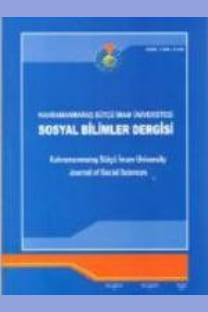Türkiye’de Yerel Turizm Ofislerinin Web Site İçeriklerinin Değerlendirilmesine Yönelik Bir Araştırma
İnternet, Web Site İçeriği, Yerel Turizm Ofisi, Türkiye
A Content Evaluation Of Local Tourism Offices Website In Turkey
Internet, Website Content, Local Tourism Office, Turkey,
___
- Au, N. ve Ekiz E. H. (2009). Issues And Opportunities Of Internet Hotel Marketing In Developıng Countrıes, Journal of Travel & Tourism Marketing, Vol:26, No:3, 225-243.
- Avcıkurt, Cevdet (2010). Turizmde Tanıtma ve Satış Geliştirme, İstanbul: Değişim Yayınları.
- Baggio, R. (2003). A Websites Analysis of EuropeanTourism Organizations, Anatolia: An International Journal of Tourism and HospitalityResearch, Vol:14, No:2, 93-106.
- Bahar, Ozan ve M. Kozak (2005). Türkiye Turizminin Akdeniz Ülkeleri ile Rekabet Gücü Açısından Karşılaştırılması, Anatolia: Turizm Araştırmaları Dergisi, Cilt:16, Sayı:2, 139-152.
- Cho, M.-H. ve Sung H. H. (2012). Travel Destination Websites: CrossCultural Effects on PerceivedInformation Value and Performance Evaluation, Journal of Travel & Tourism Marketing, Vol:29, No:3, 221-2
- Cobos, L. M., Wang Y., ve Okumus F. (2009). Assessing the Web-Based Destination Marketing Activities: A Relationship Marketing Perspective, Journal of Hospitality Marketing & Management, Vol:18, No:4, 421-444.
- Doolina, B., Burgess, L. ve Cooper, C. (2002). Evaluating The Use Of The Web For Tourism Marketing: A Case Study From New Zealand, Tourism Management, 23(5), 557–561.
- Giannopoulos, A. A. ve Mavragani E. P. (2011). Traveling Through theWeb: A First Step Toward a Comparative Analysis of European National Tourism Websites, Journal of Hospitality Marketing & Management, Vol:20, No:7, 718-739.
- Ip, C., Law R. ve Lee Andy H. (2012). The Evaluation of Hotel Website Functionality by Fuzzy Analytic Hierarchy Process, Journal of Travel & Tourism Marketing, Vol:29, No:3, 263-278.
- Köroğlu, Ahmet ve Geyik Serkan (2010). Otel İşletmelerinin Web Sayfalarının İçerik Analiziyle Değerlendirilmesi: Karşılaştırmalı Bir Çalışma, Uluslararası Turizm Ve Otelcilik Sempozyumu, Beyşehir. Köroğlu, Ahmet, Karaman Sebahattin ve Geyik Serkan (2011). Pazarlama İletişimi Aracı Olarak İnternet: Butik Otellerin Web Sayfalarının İçerik Analizi Yöntemi İle İncelenmesi, 12. Ulusal Turizm Kongresi Bildiriler Kitabı, Akçakoca.
- Li, X. ve Wang Y. (2011). Measuring The Effectiveness Of US Official State Tourism Websites, Journal of Vacation Marketing, Vol:17, No:4, 28730
- Loda, M. D., Teichmann K. ve Zins A. H. (2009). Destination websites' persuasiveness, International Journal of Culture, Tourism and Hospitality Research, Vol:3, No:1, 70–80.
- Morasan, C. (2008). DMO Websites and the Role ofComplementary Media in Tourism Advertising, Journal of Hospitality & LeisureMarketing, Vol:17, No:1-2, 216-236.
- Ölçer, Ferit ve Özyılmaz Adnan (2007). Elektronik Ticaret Ve Sanal Organizasyonlarda Uygulanması. Süleyman Demirel Üniversitesi, İİBF Dergisi, Cilt:12, Sayı:2, 67- 94.
- Perdue, R.R. (2008). Internet Site Evaluations: The Influenceof Behavioral Experience, Existing Images, and Selected Website Characteristics, Journal of Travel & Tourism Marketing, Vol:11, No:2-3, 21-38.
- Romanazzi, S., Petruzzellis L., ve Iannuzzi E. (2011). ‘Click & experience. Just virtually there.’ The Effect of a Destination Website on Tourist Choice: Evidence from Italy, Journal of Hospitality Marketing & Management, Vol:20, No:7, 791-813.
- Roney, S. A. ve Özturan M. (2006). A Content Analysis of the Web Sites of Turkish Travel Agencies, Anatolia: An International Journal of Tourism and Hospitality Research, Vol:17, No:1, 43-54.
- Sangpikul, A. (2010). Marketing Ecotourism Through the Internet: A Case of Ecotourism Business in Thailand, International Journal of Hospitality & Tourism Administration, Vol:11, No:2, 107-137.
- Schmidt, S., Cantallops A. S. ve Santos C. P. (2008). The characteristics of hotelwebsites and their implications for website effectiveness. Tourism Management, Vol:28, No:2, 504-516.
- Sigala, M. (2011). Evaluating Website Design and Structure in Tourism:Dimensions, Stakeholders and Marketing Issues, Journal of Hospitality Marketing & Management, Vol:20, No:7, 691-694.
- So, S.-I. A. ve Morrison A. M. (2004). Internet Marketing in Tourism in Asia: An Evaluationof the Performance of East Asian National Tourism Organization Websites, Journal of Hospitality & Leisure Marketing, Vol:11, No:4, 93-118.
- Stringam, B. B., ve Gerdes J. (2010). Are Pictures Worth A Thousand RoomNights? Success Factors For Hotel Web Site Design, Journal of Hospitality and Tourism Technology, Vol:1, No:1, 30-49.
- Tutar, Filiz, Kocabay Meral ve Kılınç N. (2007). Turizm Sektöründe ETicaret Uygulamaları: Nevşehir Örneği, Selçuk Üniversitesi Karaman İ.İ.B.F. Dergisi, Cilt:12, Sayı:9, 196-206.
- UNWTO, Tourism Highlights, 20 http://www.unwto.org/facts/eng/highlights.htm, (25.07.2013)
- UNWTO, Tourism highlights, 2012, https://s3-eu-westamazonaws.com/storageapi/sites/all/files/docpdf/unwtohighlights12enlr _pdf, (25.07.2013)
- Vrana, V. ve Zafiropoulos K. (2011). Associations Between USPs and DesignCharacteristics of Mediterranean Countries' Websites, Journal of Hospitality Marketing & Management, Vol:20, No:7, 766-790.
- Yen, B., Hu P. J. Ve Wang M. (2007). Toward an Analytical Approach forEffective Web Site Design: A Framework for Modeling, Evaluation and Enhancement, Electronic Commerce Research and Applications, Vol:6, 159-170. http://internetworldstats.com/stats.htm, (12.02.2012) http://www.thinkwithgoogle.com/insights/library/studies/travelers-road-todecision-2011/, (10.02.2011)
- ISSN: 1304-8120
- Yayın Aralığı: 3
- Başlangıç: 2004
- Yayıncı: Kahramanmaraş Sütçü İmam Universitesi
İslamiyet’ten Önce Türk Devletlerinde Meclis Anlayışı: Toy, Kengeş, Kurultay Örneği
Kahramanmaraş İlinde Belediye Teşkilatı Bulunan Yerleşmelerin Fonksiyonel Analizi
İbrahim KIR, Cüneyt Altan ALTAY, Erkan CEYHAN
Effects Of Separation Of Power On American Federal Goverment
Geçmişten Günümüze Türkiye’de Yerel Yönetimler
İbrahim Serbestoğlu, Osmanlı Kimdir? Osmanlı Devleti’nde Tabiiyet Sorunu
Schumpeter Ve Yeniliklerin Finansmanı
Süleyman GÖKSOY, Engin EMEN, Şenyurt YENİPINAR
Türkiye’de Yerel Turizm Ofislerinin Web Site İçeriklerinin Değerlendirilmesine Yönelik Bir Araştırma
